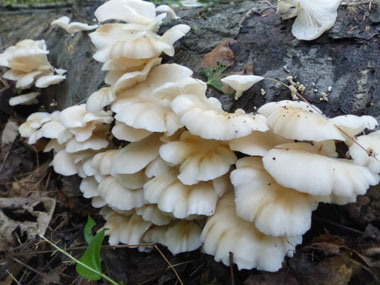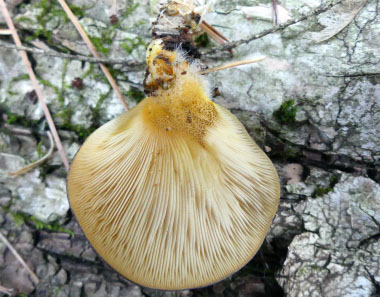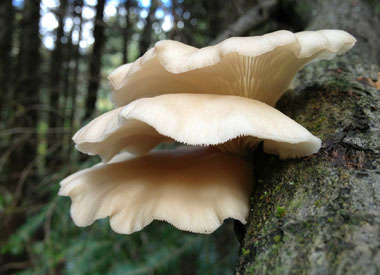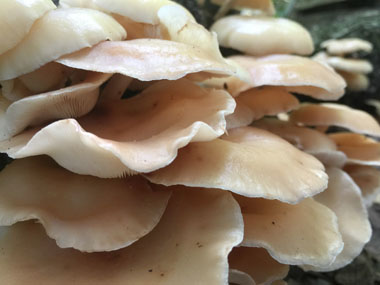







Do not eat any fungi that has not been properly identified by a qualified professional, some are DEADLY when ingested. All edible wild fungi MUST be cooked.
This mushroom is close relative to the King Oyster mushroom. The Japanese call it Hiratake, which means the ‘flat mushroom’. Amazingly, the oyster mushroom is also carnivorous with its victim being the nematode, an animal that is itself parasitic.
Type
Distinguishing Features
Oyster mushrooms have a white to light brown to a darker brown, funnel-shaped cap, with whitish- yellow gills running up a short off-center stem. The flesh is white. The cap is usually 5 to 25cm (2 to 10”) across and it grows in a shelf-like formation often with overlapping clusters. Gills are white and decurrent. The stem is very short, stout, lateral, and they are somewhat hairy near the base.
Height
Stalks are short and stout measuring 2.5 to 10 cm (1 to 4 inches).
Habitat
Oysters are saprotrophic so they are found growing on logs, or on unhealthy or dying trees. They are commonly found on deciduous hardwoods, especially beech and aspen trees. They are rarely found on conifers as well. They can be found in forests in sub-tropical and temperate climates.
Spore Print
White to grey or slightly lilac grey.
Season
Summer and autumn, or in warmer climates they can be found in winter as well depending on geographic location.
Gills
Decurrent gills that are close. Whitish or with a gray tinge and sometimes yellowish when aged.
Edibility
Oyster mushrooms have a delicate, mild flavour with a velvety texture. Can be eaten raw or cooked although raw means that it probably won’t digest properly.
Other Name
Tree Oyster.
Many thanks to Keara Giannotti, owner of Camp Creek Run in New Jersey for supplying the image of the young oysters..
To support our efforts please browse our store (books with medicinal info, etc.).
Winter Survival Food Handbook

PDF Plant Magazines
Types of Wild Food
Geographic Zones Seasons
Disclaimer
EdibleWildFood.com is informational in nature. While we strive to be 100% accurate, it is solely up to the reader to ensure proper plant identification. Some wild plants are poisonous or can have serious adverse health effects.
We are not health professionals, medical doctors, nor are we nutritionists. It is up to the reader to verify nutritional information and health benefits with qualified professionals for all edible plants listed in this web site. Please click here for more information.
Why Edible Wild Food?
- Food costs are rising
- Free, wild food is readily abundant
- Wild food adds nutrition to your diet
- Wild food can help treat various medical conditions







